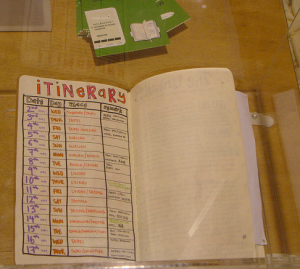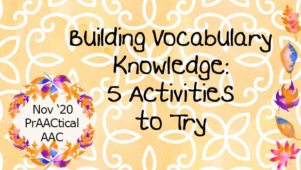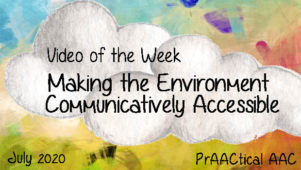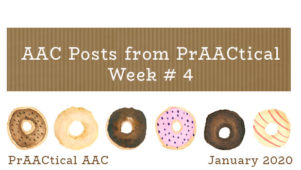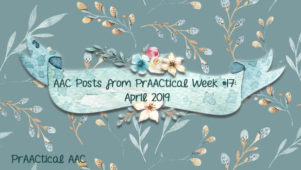Complete Vocabulary Instruction Ideas & Activities
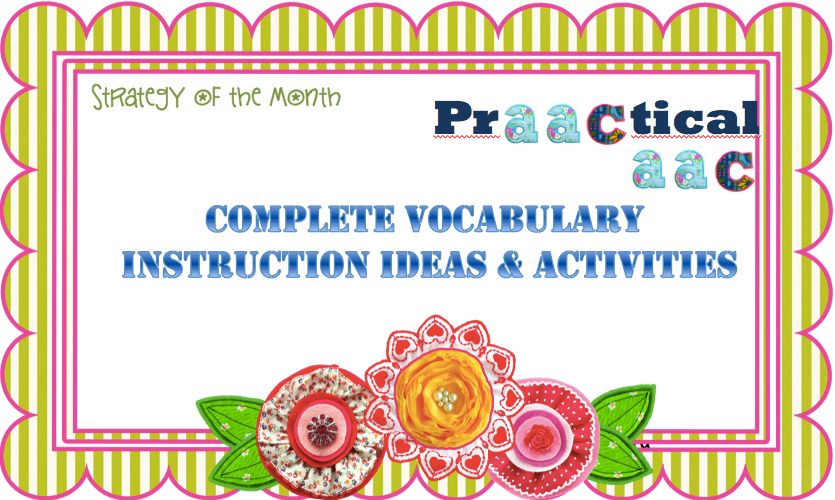
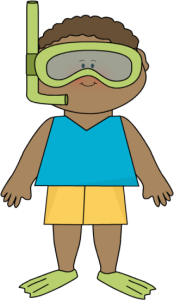 We love incorporating new vocabulary into fun motivating activities even when we are doing direct vocabulary instruction. We embed new vocabulary in activities using all of the language modalities- reading, writing, talking, and listening. We use planned vocabulary instruction activities as well as unexpected opportunities to embed new vocabulary. We like to stay within the theme of vocabulary learning but try and stay flexible in case a perfect opportunity arises that allows us to reflect back on an old vocabulary theme or mention a future planned theme. The main goal of direct vocabulary instruction is more than learning a new list of words, it is learning robust word knowledge so that language skills can be broadened.
We love incorporating new vocabulary into fun motivating activities even when we are doing direct vocabulary instruction. We embed new vocabulary in activities using all of the language modalities- reading, writing, talking, and listening. We use planned vocabulary instruction activities as well as unexpected opportunities to embed new vocabulary. We like to stay within the theme of vocabulary learning but try and stay flexible in case a perfect opportunity arises that allows us to reflect back on an old vocabulary theme or mention a future planned theme. The main goal of direct vocabulary instruction is more than learning a new list of words, it is learning robust word knowledge so that language skills can be broadened.
Consider these vocabulary instruction steps by Robert Marzano. These steps were not specifically developed for AAC users but if we add a language focus and a little more fun and active participation, they fit with what we have been writing about all month.
Step 1: The facilitator explains a new word, going beyond reciting its definition. Use language facilitation strategies such as scaffolding to build upon prior knowledge of the word, use pictures and visual supports (tap into prior knowledge of students, use imagery). Let learners interact with the materials, use group communication devices so learners can participate in the conversation.
Step two: Students restate or explain the new word in their own words. Use choice boards with word associations to help the beginning communicator participate. Use pictures, symbols, text to help students re-state words. Have learners find words ‘like’ the target vocabulary. Use vocabulary word clouds or books to have learners find words that help them restate or explain the words.
Step three: Ask students to create a non-linguistic representation of the word. Have students assemble or find objects to represent the word. Have students pick a color or use a rating scale about aspects of the words. Go on vocabulary scavenger hunts to find representations of the words. It is important to let learners think outside the ‘box’ here. You can use blocks, people, equipment to represent the words. Many times our kids will surprise us and even come up with a non-linguistic representation we don’t ‘get’ at first. But then usually we figure it out and it works better than we had thought. Take pictures of everyone’s representations and arrange into a ‘power point’ movie. Eat popcorn or some other preferred snack as you watch the vocabulary come to life. If food is not an attraction for your learners, sit in special comfy chairs, or add super fun music to the power point. Always look for what will make the experience motivating. Learners can be assigned ‘jobs’ or roles to the ‘vocabulary movie experience’. There can be invitations, a ‘movie operator’ to advance the slides. Since we often work with one learner at a time, we invite families, siblings, other clinicians, sometimes a favorite office assistant to attend. Think about the natural reinforcement and feedback a learner gets with this.
Step four: Students (learners) engage in activities to deepen knowledge of the new word. Deepening vocabulary knowledge can be accomplished through poems, classification, rating scales, comparing & contrasting target words. This is also where we build in multiple opportunities to USE new vocabulary. We have learners participate in short skits, do obstacle courses that are dependent on using target vocabulary to continue on the ‘path’. We use word walls and word boxes. As always, our activities will depend on the motivations of the learner. There is never a reason to go to the place that says ‘there is nothing that he likes’. All that really says to be quite honest is that we do not know how to do our job. Instead, we readily admit there are times we do not know things. This is when we go to our ‘personal learning network’ and talk to colleagues, go web ‘surfing’, go to pinterest, twitter, etc until we find an answer. We also always remember to get input from family when possible because they almost always have great insight if… we ask the right questions.
Step five: Students discuss the new word (pair-share, elbow partners). Some students will love this vocabulary instruction time and work well with partners, while others are not naturally good at interacting with peers. For those who need more help, make the pair/share more specific. Have each learner participate in part of the activity to make it whole. In this context, one learner may hold a vocabulary box while the other puts vocabulary pictures in. Then they switch roles. We may also do pair/share when we have reverse inclusion experiences or ‘peer buddies’ but we try to make sure it is done with a variety of peers.
Step six: Students play games to review new vocabulary . This is a time for even more games than above. For AAC learners, the games should be highly motivating. Games can follow predictable patterns and or be novel at times. Vocabulary recipes, bingo , bean bag toss are great ideas but we try and relate the game in some way to the vocabulary theme rather than having unrelated words that just have a fun experience. We might relate a word like ‘rapidly’ to a timed bean bag game or a word like ‘coordinate’ to a group recipe.
“Direct vocabulary instruction is fundamental to effective teaching” by Robert Marzano
To expand on this, use all of the effective language facilitation, communication-behavior, and reinforcement teaching strategies and apply them to direct vocabulary instruction with AAC learners.
Please share with us your favorite vocabulary instruction activities.
5 Additional Resources for Vocabulary Direct Instruction
- Cool Tools for Teaching Vocabulary- http://d97cooltools.blogspot.com/2011/07/cool-tools-for-teaching-vocabulary.html
Resources for word clouds, visual dictionaries, word video’s, and much more. - Vocabulary Games for the Classroom- http://www.marzanoresearch.com/reproducibles/vocabulary_games.aspx#reproducibles By Lindsay Carleton and Robert J. Marzano
- Teaching Vocabulary-
http://www.readingrockets.org/article/9943/ Reading Rockets - Top 13 Vocabulary Apps- http://www.readingrockets.org/teaching/reading101/vocabulary/literacyapps_vocabulary/
- One Easy Way to Increase Vocabulary on AAC Devices- Adapting Creatively http://adaptingcreatively.blogspot.com/2012/07/one-easy-way-to-increase-vocabulary-on.html
Filed under: Strategy of the Month
Tagged With: language, vocabulary instruction
This post was written by Robin Parker
